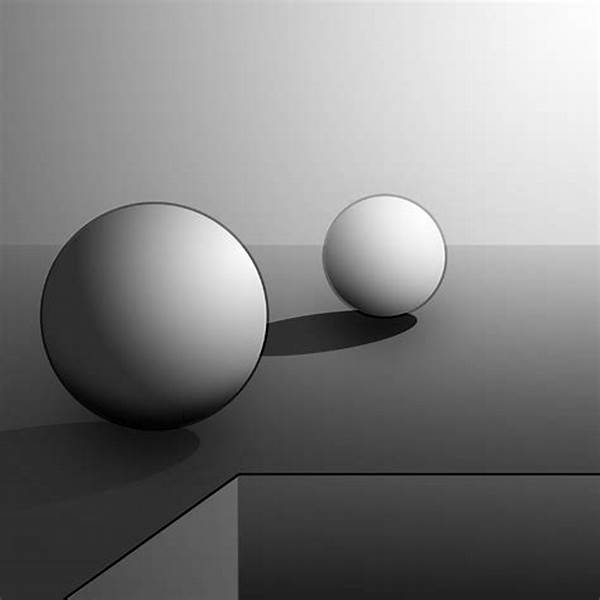Creating Depth In Design With Shadows

In the world of design, shadows are like the unsung heroes, quietly working their magic in the background. Picture this: you’re scrolling through your favorite app, and something about the layout just clicks. It’s sleek, it’s engaging, and it feels almost three-dimensional. You may not notice it at first, but the subtle play of light and shadow creates a sense of depth and realism that pulls you in. It’s like a whisper in your ear, beckoning you to explore further. Shadows in design are like the spices in a well-cooked meal; if used just right, they add the perfect flavor, making everything else come alive.
Read Now : Functional Vest Designs For Photographers
The Art of Creating Shadows
When you’re creating depth in design with shadows, it’s not just about tossing a drop shadow here and a darker shade there. Nah, it’s all about crafting an experience. Think of it like a selfie on point; the lighting’s gotta be just right. Shadows can make elements pop, give importance to different parts, and lead the eye on a journey through the page. You’re basically the tour guide to the viewer’s adventure, showing them where to look and what to feel. Shadows add drama, you know? Just like how Netflix hasn’t been the same since they dimmed Stranger Things.
What’s more, when creating depth in design with shadows, it’s also about subtlety. Too much shadow, and your design looks like it came straight outta a horror movie. Too little, and it’s a flat pancake of meh. It’s all about balance, a bit like life, really. The trick is to experiment, mix and match, and eventually, you’ll find that sweet spot where everything harmonizes. Like tuning a guitar; once it’s in tune, the music flows, and you can’t help but tap your feet.
Shadows Layering: The Designer’s Secret Sauce
Creating depth in design with shadows is a bit like building a cake. Yeah, layers! Here are some quick hacks:
1. Soft Shadows: Start gentle, ya know? Soft shadows create a more natural look, like sunlight sneaking through the curtains.
2. Hard Shadows: These bad boys are all about drama. Think bold, edgy, like a rockstar entrance.
3. Colorful Shadows: Who says shadows have to be gray? Throw in a color twist and watch the magic happen.
4. Layering: Stack ‘em up, but keep it classy. Too many can look like a mess—less is definitely more.
5. Consistency: Keep your style in check. Like, don’t go mixing Positano pastels with Gotham gray shadows. Stay true to your vibe.
The Evolution of Shadows in Digital Design
As digital design evolves, so must our techniques, especially when creating depth in design with shadows. In the past, shadows were just a way to make icons look clickable, but now, they’re absolutely transformative. They are the bridge between two-dimensional screens and a three-dimensional feel. This isn’t your grandma’s shadow trick either; it’s a new-age finesse akin to the transitions and gradients that keep things looking fresh and modern.
Today, designers use shadows to not only add depth but also to tweak the mood and tone, giving websites and apps distinct personality. You’ve got the soft whisper of a shadow giving off zen vibes, or the dramatic impact of a bold shadow bringing to life a punk rocker’s manifesto. It’s a whole vibe check! Shadows have the power to transform the mundane into something that’s got splash and street cred. They’re the cherry on top, the kicker in your morning joe, the snapback to your everyday style.
Creative Techniques for Depth with Shadows
Embracing the art of creating depth in design with shadows opens up a world of possibilities. Check these ideas:
1. Shadow Gradients: Blend it, baby! Use gradients for a seamless transition of color and depth.
2. Ripple Shadows: Like a dream catcher of shadows, ripples add mystique.
Read Now : Contemporary Seaside Home Decor
3. Offset Shadows: Shift horizontally or vertically for a 3D pop.
4. Texture Shadows: Inject some tactile feels with subtle grunge or noise.
5. Interactive Shadows: Engage users with shadows that react to movements or clicks.
6. Animated Shadows: Make ‘em dance with looped or triggered animations.
7. Inverse Shadows: Flip the script, use light within shadow for a surreal twist.
8. Geometric Shadows: Let angular shapes create contrast and focus.
9. Focal Shadows: Draw focus to elements by playing with light sources.
10. Minimalist Shadows: Sometimes low-key wins the day; barely-there shadows lift the design.
Subtle Shadow Play
You get it, right? Creating depth in design with shadows is more than a one-trick pony. It’s all these combinations and touches of personal flair that really make a piece standout. Yah, the details matter! Play around, but keep things real. Push boundaries, but check your consistency. Your designs will thank you for it.
When you’re steering your creative ship through uncharted design waters, remember—have fun! Mix it up, keep it fresh, and be unapologetically bold. Stick to these shadow play tricks and tips, and you’ll be layering design depth like a master chef serving an immaculate soufflé, and you know that’s no easy feat! We’re talking prime-time design elevation and swagger.
Shadow Trends That Never Fade
Let’s wrap it up with a little love for the timeless trend of creating depth in design with shadows. It’s like the little black dress or a worn-in pair of Converse—never goes outta style. This timeless trick continues to evolve, influencing design generation after generation. Just think about how shadows shift with the sun—they’re always changing, but they’re also consistent like your best friend listening to you ramble about your latest design conundrum. Shadows are here to stay, quietly enhancing every design adventure you dare to embark on.